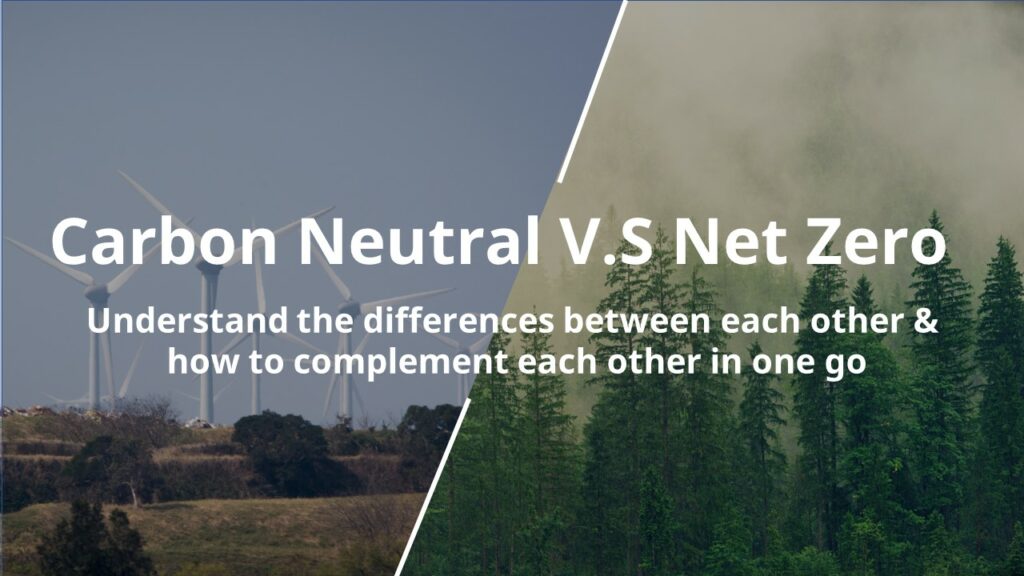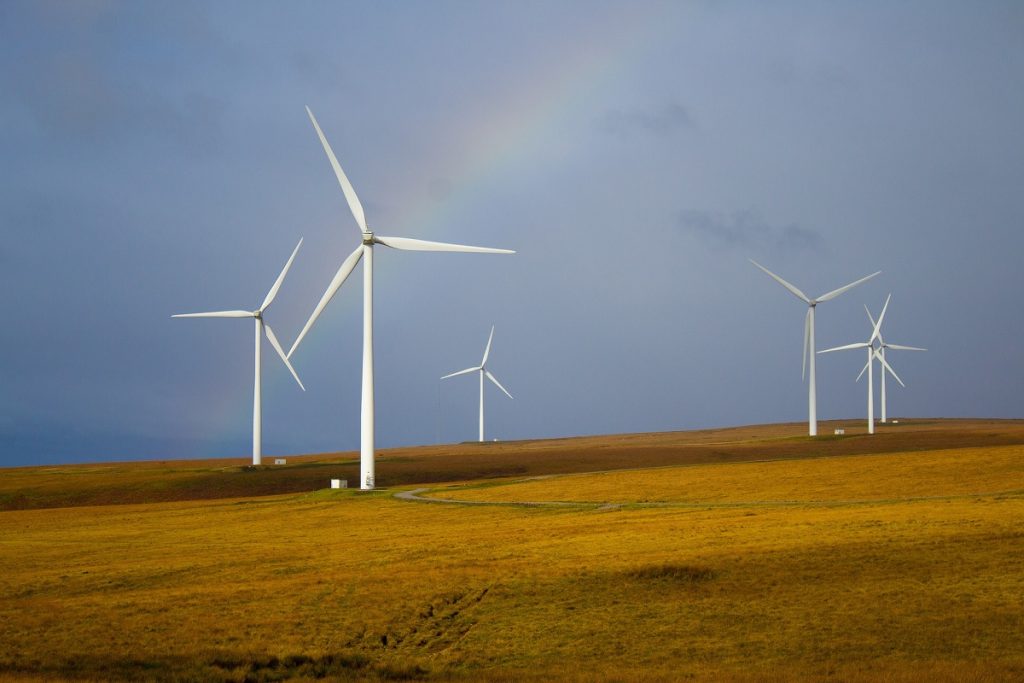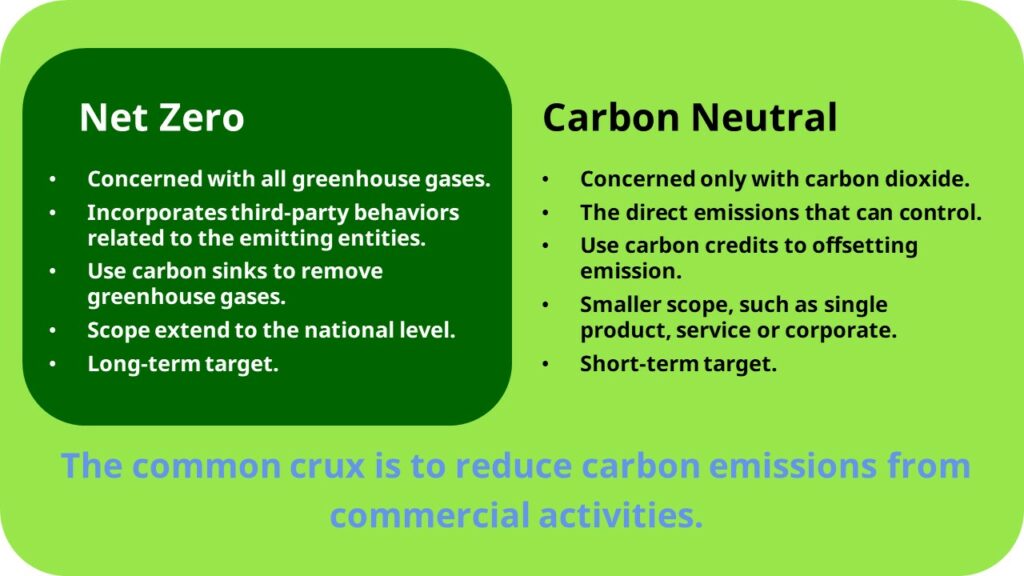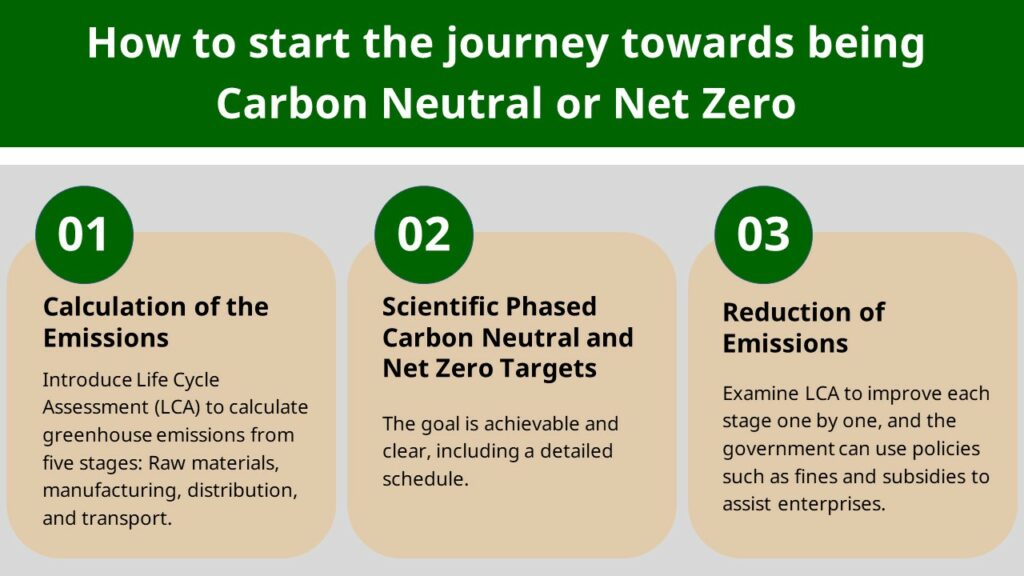
Carbon neutral and net zero are the terms mentioned most frequently in recent years, and they are mixed frequently, too. In fact, carbon neutral means the offset of directly generated carbon emissions while net zero means that the total emissions of all greenhouse gases are zero. Both are somewhat different. This article provides detailed explanations of both terms and the status quo of their applications. Illustrations are used for quick understanding of the differences and recommendations on the implementation are proposed.
What is Carbon Neutral: The first step towards net zero

Carbon neutral is defined as the elimination of carbon emissions generated directly by organizations or individuals through carbon offset from carbon credits. The source of carbon credits is man-made carbon sinks (a system in which carbon absorption is higher than emission), such as forest restoration related projects, direct afforestation or peatland restoration, where the outcome is a reduction in carbon emissions, such as the protection of forests from felling and the introduction of renewable energy or energy saving facilities. As the principle shows, the carbon emitted at A and reduced at B is balanced eventually through the carbon cycle on the earth.
For example, the sources of direct carbon emissions at the Ford Motor Company may include fuel for parts and finished vehicle transportation, internal thermal power generation, and landfill and incineration of waste generated by the factory. When carbon credits under the same quota are bought, these carbon emissions can meet the PAS 2060 or other standards and carbon offset can be conducted. These carbon credits can then be cancelled to achieve carbon neutrality. Since the sources of the direct carbon emissions can be controlled by the company, the calculation is relatively easy. And since the current market price of the carbon credit is not expensive, carbon neutral can be more easily achieved. This is the first step toward net zero. However, for use of the carbon offset, it is important that the company take carbon reduction measures first to avoid falling into a behavior of buying indulgence to gloss over the high amount of carbon emissions.
What is Net Zero: 2050 Challenge

Net zero is the ultimate goal for our climate actions. Many countries have paid close attention to the issues of carbon emissions since the end of the 20th century. Specific actions include the United Nations Framework Convention on Climate Change (UNFCCC) signed by 197 member states in 1992 and the Conference of the Parties (COP) held every year from 1995. The parties signed the “Kyoto Protocol” and “Paris Agreement” at the conference in 1997 and 2015, respectively. All these efforts aim to control the rise of the global temperature to within 1.5 Celsius above pre-industrial revolution levels (the average value between 1850 and 1900).
In 2018, the Intergovernmental Panel on Climate Change (IPCC) put forward the concept of “2050 net zero” with reference to the global temperature rising model and pathway. As it indicates, to control the rise of the temperature to within the 1.5 Celsius limit, greenhouse gas emissions must be reduced by 45% by 2030 and the goal of net zero must be achieved by 2050, the time when all greenhouse gas emissions generated by people can be absorbed by corresponding carbon sinks. In addition to carbon dioxide, IPCC incorporates methane, nitric oxide, chlorofluorocarbon, and other gases that may lead to the greenhouse effect, and will ensure that indirect greenhouse gas emissions are controlled.
Taking the Ford Motor Company as an example again, to accomplish net zero, the behaviors to which attention is needed include, in addition to power consumption and transportation, manufacturing and transport of raw materials for steel and plastics, treatment of household waste generated by employees at work, travel of employees, gasoline burned when consumers use their vehicles, recycling of scrapped vehicles, landfill and incineration, and the greenhouse gas emissions generated by these behaviors. The carbon emissions inevitably left over after carbon reduction measures must be offset by creating carbon sinks such as afforestation, carbon capture and sequestration rather than using the carbon credits generated from the outcome of carbon reduction. Hence, carbon neutral is currently used as a short-term target and efforts are made continuously to march toward net zero.
Net zero is a long-term target as technology must to be upgraded for some measures to become actionable for the reduction of carbon emissions or an increase in carbon sinks. Meanwhile, implementation may lead to inequality in the development of a country, transformation of the employment structure and rising costs for corporations. It is up to the joint efforts of the individual, corporation, organization and even country to achieve the goal of net zero by 2050 and control the rise of the global temperature within the 1.5 Celsius limit.
For more details on Net Zero, please read this article: What is net zero? How to get net zero right?
So, What’s the difference between Carbon Neutral & Net Zero

The major differences between carbon neutral and net zero are described below:
- Carbon neutral is concerned only with carbon dioxide while net zero is concerned with all greenhouse gases.
- The emitting behavior that carbon neutral is concerned with is only the direct emissions that organizations or individuals can control while net zero incorporates third-party behaviors related to the emitting entities.
- The carbon neutrality of the remaining carbon emissions left after organizations or individuals have taken carbon reduction measures can be accomplished through carbon credits and offsets, while net zero requires the creation of actual carbon sinks and the carbon offset is conducted in a more rigorous manner.
- In principle, carbon neutral is involved in a relatively smaller scope and focuses on a single product, service or corporate, while the net zero may extend to the national and even global levels.
- To sum up, carbon neutral is achieved more easily than net zero and is usually used as a short-term target.
Why we have to achieve Carbon Neutral or Net Zero

Climate change is one of the most serious issues immediately facing humanity. It will lead to drought, flood, record-breaking high and low temperatures, rising sea levels, species extinction and other natural disasters, food threat, and water and living environment security. According to the 2023 Global Risks Report released by the World Economic Forum (WEF), the top three risk severities in the next ten years, “Failure to mitigate climate change”, “Failure of climate-change adaptation” and “Natural disasters and extreme weather events”, are associated with climate change.
Climate change is a result of the greenhouse effect and the tremendous amount of greenhouse gases emitted after the industrial revolution surely has something to do with it. Only the accomplishment of the carbon neutral and net zero can curb the further threat of the greenhouse effect. According to the IPCC’s Special Report on Global Warming of 1.5°C (SR15), when the global temperature rises by 1.5°C, the extreme heat at mid latitude will rise by 3°C; when the global temperature rises by 2°C, the extreme heat at the same latitude will rise by 4°C with concomitant global heavy rainfall and flooding, further bringing about more risk to our health, livelihood, food security, water supply and economy.
The greenhouse gas emissions generated by people can be eliminated through carbon neutral and net zero. These is helpful to reduce global warming, stop the treat that the extreme climate brings to the security and economic development of humankind.
3 ways to start the journey towards being Carbon Neutral or Net Zero
The core purpose of carbon neutral and net zero is to reduce the carbon generated by the behaviors of the emitting entities. The steps that corporations and countries use to implement carbon neutral and net zero are generally described below:

Calculation of the Emissions
A reduction of carbon emissions is necessary to accomplish both carbon neutral and net zero. The first step is understanding the current carbon emission status in order to check and identify the part where improvements can be made for carbon reduction. To calculate carbon emissions accurately, ISO 14064-1:2018 is usually applied to organizations while ISO 14067:2018 and PAS 2050 are applied to products for scientific carbon verification. The concept of Life Cycle Assessment (LCA) is introduced for detailed inspection at five stages from acquisition of raw materials, manufacturing, distribution and transport, consumer use to disposal and recycling. Both direct and indirect emissions sources are incorporated and an emission factor is provided to convert methane and other greenhouse gases into carbon dioxide equivalents that have the same effect. These are helpful for consistent calculation and comprehensive comparison of the carbon emissions in the entire life cycle.
Scientific Phased Carbon Neutral and Net Zero Targets
Carbon neutral and net zero are targets that cannot be accomplished immediately. Even for carbon neutral, the proportion of the carbon offset must be reduced through proper reduction in carbon emissions generated by the behaviors of the entities. Net zero, in particular, cannot be accomplished without long-term efforts. Hence, scientific phased targets must be established or circumstances may arise where the great ideal of carbon neutral by 2030 and net zero by 2050 are set up while the carbon emissions generated by the behaviors of the entities are not reduced until 2045, and consequently the original goals are given up when they are found to be impossible missions.
The scientific carbon reduction targets can be set up with reference to SBTI. Reduction of emissions is performed reasonably and systematically in consideration of existing resources. It is advisable to commence the reduction as soon as possible. According to the research, when reduction of carbon emissions is delayed for one year, there will be a loss of two years for the accomplishment of net zero within the 1.5 Celsius limit of temperature rise. Furthermore, if climate change leads to forest fires or ocean acidification affects the marine ecosystem and the natural carbon sinks are reduced as a result, the flexibility in solving problems may be lost due to the lack of appropriate emission reduction at an earlier stage.
Reduction of Emissions
The calculation of carbon footprints may help corporations understand the share of the carbon emissions at each stage of the life cycle assessment. Organizations and the corporations supplying the product may reduce carbon emissions based on the result of carbon verification. For example, as the carbon label of Coca Cola Taiwan shows, the carbon footprint of its cola in a 600ml plastic bottle at each stage of the life cycle is 81.33% for raw material production and distribution, 8.57% for product manufacturing, 9.46% for distribution and retail, 0.00% for use and 0.64% for disposal. The carbon emissions generated from the cola are reduced using different methods including application of recycled packaging plastics and the setup of solar energy facilities in the factory to replace part of the electricity, resulting in a reduction of carbon emissions generated from raw material production and distribution and product manufacturing.
To reduce the emissions at the national level, Cap & Trade, Carbon Border Adjustment Mechanism (CBAM), subsidies for renewable energy and other political means are used to reduce the carbon emissions generated by domestic industries. For Cap & Trade, a specific carbon allowance is assigned to corporations and they are allowed to trade between themselves in order to meet the requirements of the Cap & Trade. Any company whose carbon emissions exceed the allowance will be punished with a fine several times the cost on the trade market of the carbon allowance. As for the CBAM, the carbon intensity of the domestic industry is calculated (carbon emissions divided by production value) first and an additional customs duty is imposed on the part of the imported goods that exceeds this intensity. It is favorable for corporations to maintain their competitive strength while facing rising costs resulting from carbon reduction actions. Subsidies are provided for the development of renewable energy to improve the domestic power structure and reduce the carbon emissions that corporations purchasing electricity cannot control.
Summary
Carbon neutral and net zero measures must be implemented urgently in the face of the climate change. Although the core purpose of both is to reduce carbon emissions, net zero have a more rigorous definition than carbon neutral. It incorporates all greenhouse gases that may bring about the greenhouse effect and requires elimination of all inevitable carbon emissions by means of air carbon capture or additional afforestation to achieve the ultimate goal of stopping climate change.
There are many corresponding measures at the global level. For example, COP 26 finally incorporated the reduction of fossil fuels and doubled the amount that rich countries must provide for developing countries. The EU Emissions Trading System (EU ETS) has reduced the free carbon allowances assigned to corporations by 3% every year from 2021, meaning corporations that do not reduce emissions correspondingly may need to buy carbon allowances or even pay a heavy fine.
RE100 is formed among corporations with the intention to introduce renewable energy comprehensively. Some large corporations, such as Apple, has started requesting that their supply chain conduct carbon verification for the control of sources of indirect carbon emissions and reduce carbon emissions progressively. Microsoft achieved the target of carbon neural at the first stage in 2012. Carbon neutral and net zero have been upgraded from an environmental issue to an economic issue in which the common destiny of all the people on the earth is involved.